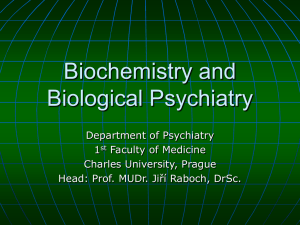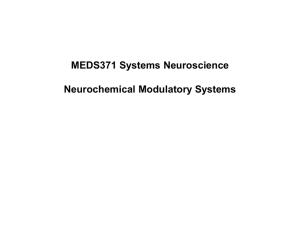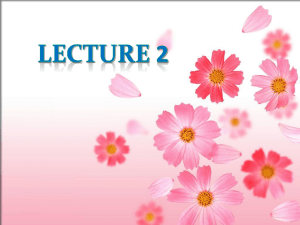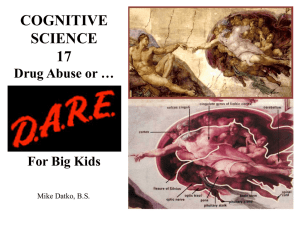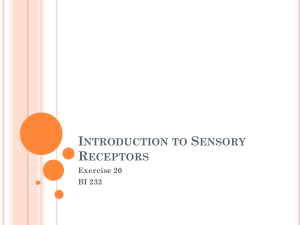Biochemistry and Biological Psychiatry
advertisement
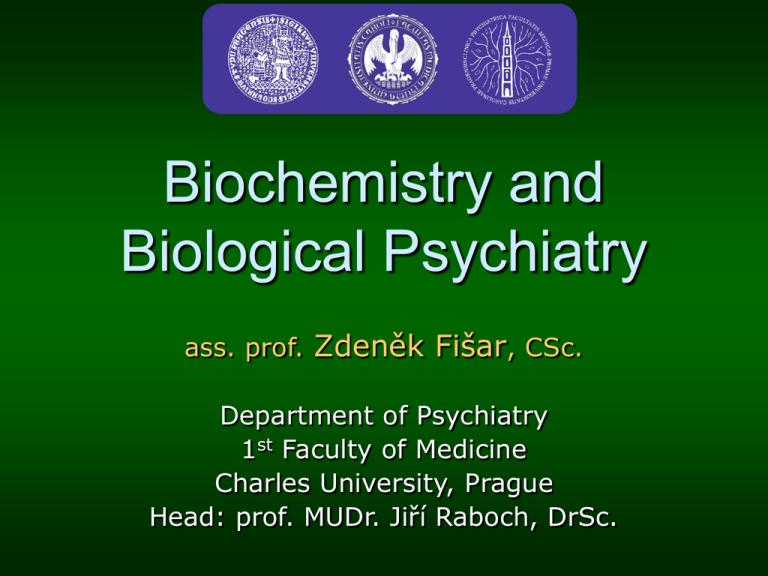
Biochemistry and Biological Psychiatry ass. prof. Zdeněk Fišar, CSc. Department of Psychiatry 1st Faculty of Medicine Charles University, Prague Head: prof. MUDr. Jiří Raboch, DrSc. Biochemistry and Biological Psychiatry cellular neurochemistry (neurons, action potentials, synapses) intercellular signalling (neurotransmitters, receptors, growth factors) intracellular signalling (G proteins, effectors, 2nd messengers, proteinkinases, transcription factors) psychotropic drugs (antipsychotics, antidepressants) biological hypotheses of mental disorders (schizophrenia, affective disorders) Biological Psychiatry: Web Pages 1. Educational portal of our faculty: http://connect.lf1.cuni.cz http://portal.lf1.cuni.cz/ (section Psychiatry, Psychology, Sexuology) 2. Direct links: http://www.lf1.cuni.cz/zfisar/psychiatry/ (presentation of lectures from psychiatry) http://psych.lf1.cuni.cz/bpen/default.htm (teaching material from biological psychiatry) Introduction Biological psychiatry studies disorders in human mind from the neurochemical, neuroendocrine and genetic point of view mainly. It is postulated that changes in brain signal transmission (at the level of chemical synapse) are essential in the development of mental disorders. Cellular Neurochemistry Neurons Action potentials Synapses Neuron The neurons are the brain cells that are responsible for intracellular and intercellular signalling. Action potential is large and rapidly reversible fluctuation in the membrane potential, that propagate along the axon. At the end of axon there are many nerve endings (synaptic terminals, presynaptic parts, synaptic buttons, knobs). Nerve ending form an integral parts of synapse. Synapse mediates the signal transmission from one neuron to another. Synapse Neurons communicate with one another by • direct electrical coupling • secretion of neurotransmitters Synapses are specialized structures for signal transduction from one neuron to other. Chemical synapses are studied in the biological psychiatry. Morphology of Chemical Synapse Chemical Synapse Signal Transduction Model of Plasma Membrane Membrane Transporters Intercellular and Intracellular Signalling Neurotransmitters Growth factors Receptors G proteins Effector systems (2nd messengers, proteinkinases, transcription factors) Criteria to Identify Neurotransmitters 1. Presence in presynaptic nerve terminal 2. Synthesis by presynaptic neuron 3. Releasing on stimulation (membrane depolarisation) 4. Producing rapid-onset and rapidly reversible responses in the target cell 5. Existence of specific receptor There are two main groups of neurotransmitters: • classical neurotransmitters • neuropeptides Selected Classical Neurotransmitters System Cholinergic Transmitter acetylcholine Aminoacidergic GABA, aspartic acid, glutamic acid, glycine, homocysteine Monoaminergic • Catecholamines • Indolamines • Others, related to aa Purinergic dopamine, norepinephrine, epinephrine tryptamine, serotonin histamine, taurine adenosine, ADP, AMP, ATP nitric oxide Catecholamine Biosynthesis Serotonin Biosynthesis Reuptake and Metabolism of Monoamine Neurotransmitters Reuptake Monoamine oxidase (MAO) Catechol-O-methyltransferase (COMT) Selected Bioactive Peptides Peptide Group substance P, substance K (tachykinins), neurotensin, brain and cholecystokinin (CCK), gastrin, bombesin gastrointestinal peptides galanin, neuromedin K, neuropeptideY (NPY), peptide YY (PYY), neuronal cortikotropin releasing hormone (CRH) growth hormone releasing hormone (GHRH), gonadotropin releasing hormone (GnRH), somatostatin, thyrotropin releasing hormone (TRH) hypothalamic releasing factors adrenocorticotropic hormone (ACTH) growth hormone (GH), prolactin (PRL), lutenizing hormone (LH), thyrotropin (TSH) pituitary hormones oxytocin, vasopressin neurohypophyseal peptides atrial natriuretic peptide (ANF), vasoactive intestinal peptide (VIP) neuronal and endocrine enkephalines (met-, leu-), dynorphin, -endorphin opiate peptides Growth Factors in the Nervous System Neurotrophins Nerve growth factor (NGF) Brain-derived neurotrophic factor (BDNF) Neurotrophin 3 (NT3) Neurotrophin 4/5 (NT4/5) Neurokines Ciliary neurotrophic factor (CNTF) Leukemia inhibitory factor (LIF) Interleukin 6 (IL-6) Cardiotrophin 1 (CT-1) Fibroblast growth factors FGF-1 FGF-2 Transforming growth factor superfamily Transforming growth factors (TGF) Bone morphogenetic factors (BMPs) Glial-derived neurotrophic factor (GDNF) Neurturin Epidermal growth factor superfamily Epidermal growth factor (EGF) Transforming growth factor (TGF) Neuregilins Other growth factors Platelet-derived growth factor (PDGF) Insulin-like growth factor I (IGF-I) Membrane Receptors Receptor is macromolecule specialized on transmission of information. Receptor complex includes: 1. Specific binding site 2. Internal ion channel or transduction element 3. Effector system (ion channels or system of 2nd messengers) Regulation of receptors 1. Density of receptors (down-regulation, up-regulation) 2. Properties of receptors (desensitisation, hypersensitivity) Receptor Classification 1. Receptor coupled directly to the ion channel 2. Receptor associated with G proteins 3. Receptor with intrinsic guanylyl cyclase activity 4. Receptor with intrinsic tyrosine kinase activity 1. Receptors with Internal Ion Channel 1. Receptors with Internal Ion Channel acetylcholine Nicotinic acetylcholine receptor is made of 5 subunits, 2 of which (shown in orange) bind acetylcholine (red). membrane receptor acetylcholine 1. Receptors with internal ion channel GABAA receptor, nicotonic acetylcholine receptors, ionotropic glutamate receptors, etc. 2. Receptors Associated with G Proteins 1. adenylyl cyclase system 2. phosphoinositide system 3. arachidonic acid system Receptors Associated with G Proteins SYSTEM Adenylyl cyclase system Phosphoinositide Arachidonic acid system system NEURONE, 5-HT, DA, TRANSMITTER Ach NE, 5-HT, DA, Ach Histamine TRANSDUCER Gs, Gi Gp Unknown Gprotein PRIMARY EFFECTOR Adenylyl cyclase Phospholipase C Phospholipase A SECONDARY MESSENGER cAMP IP3, DAG, Ca++ Arachidonic acid SECONDARY EFFECTOR •Calcium and calmoduline •Protein kinase A dependent protein kinases •Protein kinase C •5-Lipoxygenase •12-Lipoxygenase •Cycloxygenase Types of Receptors System acetylcholinergic Type acetylcholine nicotinic receptors acetylcholine muscarinic receptors monoaminergic 1-adrenoceptors 2-adrenoceptors -adrenoceptors dopamine receptors serotonin receptor aminoacidergic GABA receptors glutamate ionotropic receptors glutamate metabotropic receptors glycine receptors histamine receptors peptidergic opioid receptors other peptide receptors purinergic adenosine receptors (P1 purinoceptors) P2 purinoceptors Subtypes of Norepinephrine Receptors RECEPTORS 1-adrenoceptors 2-adrenoceptors -adrenoceptors Subtype Transducer Structure (aa/TM) 1A Gq/11 IP3/DAG 466/7 1B Gq/11 IP3/DAG 519/7 1D Gq/11 IP3/DAG 572/7 2A Gi/o cAMP 450/7 2B Gi/o cAMP 450/7 2C Gi/o cAMP 461/7 2D Gi/o cAMP 450/7 1 Gs cAMP 477/7 2 Gs cAMP 413/7 3 Gs, Gi/o cAMP 408/7 Subtypes of Dopamine Receptors RECEPTORS dopamine Subtype Transducer Structure (aa/TM) D1 Gs cAMP 446/7 D2 Gi Gq/11 cAMP IP3/DAG, K+, Ca2+ 443/7 D3 Gi cAMP 400/7 D4 Gi cAMP, K+ 386/7 D5 Gs cAMP 477/7 Subtypes of Serotonin Receptors RECEPTORS 5-HT (5-hydroxytryptamine) Subtype Transducer Structure 5-HT1A Gi/o cAMP 421/7 5-HT1B Gi/o cAMP 390/7 5-HT1D Gi/o cAMP 377/7 5-ht1E Gi/o cAMP 365/7 5-ht1F Gi/o cAMP 366/7 5-HT2A Gq/11 IP3/DAG 471/7 5-HT2B Gq/11 IP3/DAG 481/7 5-HT2C Gq/11 IP3/DAG 458/7 5-HT3 internal cationic channel 478 5-HT4 Gs 5-ht5A ? 5-ht6 Gs cAMP 440/7 5-HT7 Gs cAMP 445/7 cAMP 387/7 357/7 Feedback to Transmitter-Releasing Crossconnection of Transducing Systems on Postreceptor Level AR – adrenoceptor G – G protein PI-PLC – phosphoinositide specific phospholipase C IP3 – inositoltriphosphate DG – diacylglycerol CaM – calmodulin AC – adenylyl cyclase PKC – protein kinase C Psychotropic Drugs Biochemical hypotheses of mental disorders are based on the study of mechanisms of action of psychotropic drugs at the level of: • chemical synapse • intracellular processes connected with signal transduction Classification of Psychotropics parameter effect group watchfulness (vigility) positive psychostimulant drugs negative hypnotic drugs affectivity positive antidepressants anxiolytics psychic integrations memory negative dysphoric drugs positive neuroleptics, atypical antipsychotics negative hallucinogenic agents positive nootropics negative amnestic drugs Main Psychotropic Drugs Antipsychotics Antidepressants Anxiolytics Hypnotics Cognitives Psychostimulants Hallucinogens Potential Action of Psychotropics 1. Synthesis and storage of neurotransmitters 2. Releasing of neurotransmitters 3. Receptor-neurotransmitter interactions (agonists, antagonists) 4. Catabolism of neurotransmitters 5. Reuptake of neurotransmitters 6. Transduction element (G protein) 7. Effector's system 8. Transcription factor activity and gene expression Classification of Antipsychotics Group Conventional antipsychotics (classical neuroleptics) Atypical antipsychotics (antipsychotics of 2nd generation) Examples chlorpromazine, chlorprotixene, clopenthixole, levopromazine, periciazine, thioridazine droperidole, flupentixol, fluphenazine, fluspirilene, haloperidol, melperone, oxyprothepine, penfluridol, perphenazine, pimozide, prochlorperazine, trifluoperazine amisulpiride, clozapine, olanzapine, quetiapine, risperidone, sertindole, sulpiride, aripiprazole Mechanisms of Action of Antipsychotics Conventional D2 receptor blockade of postsynaptic in the mesolimbic pathway antipsychotics D2 receptor blockade of postsynaptic in the mesolimbic pathway to reduce positive symptoms; enhanced dopamine release and 5-HT2A Atypical receptor blockade in the mesocortical pathway to reduce negative symptoms; antipsychotics other receptor-binding properties may contribute to efficacy in treating cognitive symptoms, aggressive symptoms and depression in schizophrenia Receptor Systems Affected by Atypical Antipsychotics risperidone D2, 5-HT2A, 5-HT7, 1, 2 D2, 5-HT2A, 5-HT2C, 5-HT6, 5-HT7, D3, 1 sertindole ziprasidone D2, 5-HT2A, 5-HT1A, 5-HT1D, 5-HT2C, 5HT7, D3, 1, NRI, SRI D2, 5-HT2A, 5-HT6, 5-HT7, D1, D4, 1, loxapine M1, H1, NRI zotepine D2, 5-HT2A, 5-HT2C, 5-HT6, 5-HT7, D1, D3, D4, 1, H1, NRI clozapine D2, 5-HT2A, 5-HT1A, 5-HT2C, 5-HT3, 5HT6, 5-HT7, D1, D3, D4, 1, 2, M1, H1 olanzapine D2, 5-HT2A, 5-HT2C, 5-HT3, 5-HT6, D1, D3, D4, D5, 1, M1-5, H1 quetiapine D2, 5-HT2A, 5-HT6, 5-HT7, 1, 2, H1 aripiprazole D2, 5-HT2A, 5-HT1A, 1, 2, H1 Classification of Antidepressants (based on acute pharmacological actions) Inhibitors of neurotransmitter • monoamine oxidase inhibitors (IMAO) catabolism Reuptake inhibitors • • • • • • serotonin reuptake inhibitors (SRI) norepinephrine reuptake inhibitors (NRI) selective SRI (SSRI) selective NRI (SNRI) serotonin/norepinephrine inhibitors (SNRI) norepinephrine and dopamine reuptake inhibitors (NDRI) • 5-HT2A antagonist/reuptake inhibitors (SARI) Agonists of receptors • 5-HT1A Antagonists of receptors • 2-AR • 5-HT2 Inhibitors or stimulators of other components of signal transduction Action of SSRI Biological Hypotheses of Mental Disorders Schizophrenia Affective disorders Schizophrenia Biological models of schizophrenia can be divided into four related classes: Environmental models Genetic models Neurodevelopmental models Dopamine hypothesis Schizophrenia - Genetic Models Multifactorial-polygenic threshold model: Schizophrenia is the result of a combined effect of multiple genes interacting with variety of environmental factors. The liability to schizophrenia is linked to one end of the distribution of a continuous trait, and there may be a threshold for the clinical expression of the disease. Schizophrenia Neurodevelopmental Models A substantial group of patients, who receive diagnosis of schizophrenia in adult life, have experienced a disturbance of the orderly development of the brain decades before the symptomatic phase of the illness. Basis of Classical Dopamine Hypothesis of Schizophrenia 1. 2. 3. Dopamine-releasing drugs (amphetamine, mescaline, LSD) can induce state closely resembling paranoid schizophrenia. Antipsychotics, that are effective in the treatment of schizophrenia, have in common the ability to inhibit the dopaminergic system by blocking action of dopamine in the brain. Antipsychotics raise dopamine turnover. Classical Dopamine Hypothesis of Schizophrenia Psychotic symptoms are related to dopaminergic hyperactivity in the brain. Hyperactivity of dopaminergic systems during schizophrenia is result of increased sensitivity and density of dopamine D2 receptors. This increased activity can be localized in specific brain regions. Biological Psychiatry and Affective Disorders BIOLOGY genetics vulnerability to mental disorders stress increased sensitivity chronobiology desynchronisation of biological rhythms NEUROCHEMISTRY neurotransmitters availability, metabolism IMMUNONEUROENDOCRINOLOGY receptors number, affinity, sensitivity postreceptor processes G proteins, 2nd messengers, phosphorylation, transcription HPA increased activity during depression (hypothalamicpituitaryadrenocortical) system immune function different changes during depression Data for Neurotransmitter Hypothesis 1. Tricyclic antidepressants through blockade of neurotransmitter reuptake increase neurotransmission at noradrenergic and serotonergic synapses 2. MAOIs increase availability of monoamine neurotransmitters in synaptic cleft 3. Depressive symptoms are observed after treatment by reserpine, which depletes biogenic amines in synapse Monoamine Hypothesis Depression was due to a deficiency of monoamine neurotransmitters, norepinephrine and serotonin. Advanced monoamine theory: serotonin or norepinephrine levels in the brain are regulated by MAO-A activity mainly. However, specific symptoms of depression or mania are related to changes in the activity of monoamine transporters in specific brain regions. So, both MAO-A activity and density of transporters are included in the pathophysiology of affective disorders. Permissive Biogenic Amine Hypothesis A deficit in central serotonergic transmission permits affective disorder, but is insufficient for its cause; changes in central catecholaminergic transmission, when they occur in the context of a deficit in serotonergic transmission, act as a proximate cause for affective disorders and determine their quality (catecholaminergic transmission being elevated in mania and diminished in depression). Receptor Hypotheses The common final result of chronic treatment by majority of antidepressants is the downregulation or up-regulation of postsynaptic or presynaptic receptors. The delay of clinical response corresponds with these receptor alterations. Receptor Hypotheses Receptor catecholamine hypothesis: Supersensitivity of catecholamine receptors in the presence of low levels of serotonin is the biochemical basis of depression. Classical norepinephrine receptor hypothesis: There is increased density of postsynaptic -AR in depression. Long-term antidepressant treatment causes down regulation of 1-AR. Transient increase of neurotransmitter availability can cause fault to mania. Neurotransmitter Regulation of Mood and Behavior Dopamine Motivation Alertness Pleasure Attention Energy Interest Reward Norepinephrine Mood Anxiety Obsession Compulsion Serotonin Nutt 2008 Postreceptor Hypotheses Neurotrophic hypothesis (molecular and cellular theory) of depression: Transcription factor, cAMP response elementbinding protein (CREB), is one intracellular target of long-term antidepressant treatment and brain-derived neurotrophic factor (BDNF) is one target gene of CREB. Chronic stress leads to decrease in expression of BDNF in hippocampus. Long-term increase in levels of glucocorticoids, ischemia, neurotoxins, hypoglycaemia etc. decreases neuron survival. Long-term antidepressant treatment leads to increase in expression of BDNF and his receptor trkB through elevated function of serotonin and norepinephrine systems. Duman et al. 1997 Neurotrophic Effects of Antidepressants Nestler et al. 2002 Antidepressant Treatments Thank you for your attention Web pages: http://connect.lf1.cuni.cz http://portal.lf1.cuni.cz
